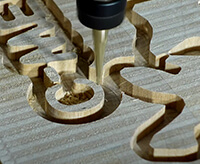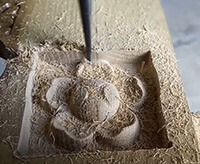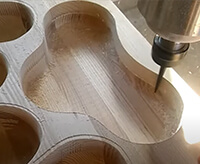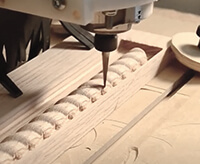Double-flute spiral Tapered ball nose router bits
Overview
Double-flute spiral tapered ball nose router bits are a cutting tool commonly used in woodworking and other materials that require cleaning, It features two spiral flutes that ensure a clean, efficient cut and a tapered ball nose that produces a rounded or bull-nosed finish on the workpiece. The Double-flute also minimizes vibration and enhances stability during operation, making it easier to create precise, detailed designs in wood and other soft materials. Whether you’re looking to add decorative touches to your wood projects, round off edges, or create intricate patterns, a Double-flute Spiral Taper Ball Nose Router Bit is the perfect tool for the job. With the added DLC coating, the bit’s lifespan and durability are increased substantially avoiding unnecessary downtime.
Mainly Application
Double-flute spiral tapered ball nose router bits are an indispensable tool for woodworkers, carvers, and engravers. precise cuts with minimal tear-out. These router bits are designed with two flutes that spiral in opposite directions and gradually taper down in diameter, which helps to create tapered cuts and angles. These router bits’ tapered cutting action makes them suited for use in applications involving a smooth and precise taper, such as furniture making, cabinetry, and other woodworking jobs. Tapered legs, chamfers, and other decorative edge treatments are typical applications using them.


Wood Router Bits
Soild Carbide Milling Cutter:
Connect Us Now
advantages of Double-flute spiral Tapered ball nose router bits
Efficient material removal
The spiral design of the bit helps to efficiently remove material from the workpiece, reducing the amount of time and effort required to complete a project.
Smooth cuts
The tapered shape of the bit allows for smooth and consistent cuts, with minimal chatter or vibration.
Reduced heat buildup
The bit’s design enables effective chip evacuation, which lowers the amount of heat that accumulates in the cutting area.

Improved accuracy
The spiral design of the bit helps to guide the tool through the workpiece, improving accuracy and reducing the likelihood of errors or mistakes.
Versatility
Double-flute spiral tapered router bits can useful for an array of applications, including cutting, routing, and shaping a range of materials, including metal, plastic, and wood.
Efficient chip removal
The spiral design of these router bits helps to remove chips quickly and efficiently, reducing the chances of clogging and overheating.
The Most Typical Of Double-flute spiral tapered router bits For Different Applications
| Item Code | Outside Diameter | Flute Length | Overall Length | Shank Diameter | R |
|---|---|---|---|---|---|
| WTB-2-D315-R1 | 3.175 | 15 | 38 | 3.175 | 0.25 |
| WTB-2-0415-R2 | 4 | 15 | 50 | 4 | 0.5 |
| WTB-2-0421-R3 | 4 | 20.5 | 50 | 4 | 0.75 |
| WTB-2-0621-R4 | 6 | 20.5 | 50 | 6 | 1.0 |
| WTB-2-0621-R5(60) | 6 | 20.1 | 60 | 6 | 1.0 |
| WTB-2-0631-R6 | 6 | 31 | 75 | 6 | 1.5 |
| WTB-2-0847-R8 | 8 | 47 | 85 | 8 | 2.0 |
| WTB-2-0860-R8 | 8 | 60 | 100 | 8 | 2.0 |
| WTB-2-0860-R8(120) | 8 | 60 | 120 | 8 | 2.0 |
| WTB-2-1060-R8 | 10 | 60 | 100 | 10 | 2.0 |
| WTB-2-1070-R8(150) | 10 | 70 | 150 | 10 | 2.0 |
| WTB-2-1270-R8(120) | 12 | 70 | 120 | 12 | 2.0 |
we are the best CNC Router Bits set manufacturers
At SUNDI, our goal is to provide you with the most cost effective and the best solutions. Our expertise, solutions, and technical support make us the ideal partner for tackling tasks, overcoming challenges, and completing projects successfully.
Professional
we have multi top class production lines which help us to offer better performance tools and extend the range of our products.
Quality
Every year, we spend a lot of money upgrading and maintaining our equipment.
in stock
We have an ample supply of goods in stock.
Team
We follow standard procedures and have an excellent team of designers.
OEM
We have many years of leading OEM and ODM manufacturing experience in this field.
Delivery
Receiving goods as fast as 3 days around the world.
Connect with the Sundi Tools Sales Team
Working principle And Applications of Double-flute spiral tapered ball nose router bits
- Double-flute spiral tapered router bits can be used for a variety of woodworking applications, including routing, profiling, and edge trimming. They are especially useful for cutting intricate designs and shaping curved edges, thanks to their smooth cutting action and precision control.

- Double-flute spiral tapered ball nose router bits work on the principle of rotary cutting. As the bit rotates, its cutting edges make contact with the workpiece and remove material by shearing and shaving it away.

- The spiral design of the bit’s cutting edges helps to channel away the material being cut, reducing the chance of clogging or overheating. The taper of the bit’s flutes helps to control the depth of the cut and allows for greater precision in shaping and profiling.

- The two cutting edges of the Double-flute spiral tapered router bits work in tandem to produce a smooth and efficient cut. The two flutes help to reduce vibration, which can result in cleaner and more accurate cuts.

- The router bit is mounted in a collet or chuck on a router motor. The motor spins the bit at high speeds, typically between 8,000 and 30,000 RPM, depending on the material being cut and the size of the bit.
Choosing the Right Double-flute spiral tapered ball nose router bits
Choosing the right spiral tapered router bits depends on several factors, . Taking the time to select the appropriate router bit can result in a cleaner, smoother cut, and a better end result.
1. Material
Different materials require different types of router bits. For example, carbide bits are suitable for cutting hard materials like metal and dense wood, while high-speed steel bits are better for softer materials like plastic and softwood.
2. Cutting depth
- The depth of the cut you need to make will also determine the type of bit you need. Tapered bits are ideal for shallow cuts, while straight bits are better for deeper cuts.
3.Finish
- The finish you want to achieve will also influence your choice of router bit. For a smooth finish, choose a bit with a high number of cutting edges, while a bit with fewer edges will leave a rougher finish.
4. Bit size
- The size of the bit will also affect the cutting performance. Larger bits are better for roughing out material, while smaller bits are better for detail work and finishing.
5. Coating
- Look for router bits with specialized coatings such as carbide or diamond, which can improve durability and performance.
6. Shank size
- The shank size of the bit needs to match the collet size of your router. Most routers have a 1/4″ or 1/2″ collet size, so choose a bit with a matching shank size.
7. Brand and quality
- Consider the reputation of the brand and the quality of the router bit. A high-quality router bit will last longer and perform better, making it a worthwhile investment for your workshop.
Tips for Using Double-flute spiral tapered ball nose router bits
- 1
Wear protective gear
Always wear safety glasses and hearing protection when using a router. It's also a good idea to wear a dust mask to protect your lungs from airborne particles.
- 2
Secure the workpiece
Use clamps or a router table to secure the workpiece in place. This will prevent it from moving during the cutting process, which can result in a poor finish or even injury.
- 3
Make multiple passes
It's better to make multiple shallow passes than one deep pass, especially when cutting dense or hard materials. This will help to reduce the load on the router and the bit, resulting in a smoother and cleaner cut.
- 4
Keep the bit sharp
Regularly check the bit's sharpness and clean it after each use. A dull or dirty bit will produce poor results and can be dangerous to use.
- 5
Follow the correct speed
Use the correct speed setting for your router and bit. Running the bit too fast or too slow can damage the bit and produce poor results.
- 6
Use the appropriate speed
Different materials and bit sizes require different speeds for optimal cutting performance. Refer to the manufacturer's recommendations for the recommended speed range for your specific bit.
- 7
Work against the rotation
When routing a profile, work against the rotation of the bit to prevent the workpiece from being pulled into the bit.


